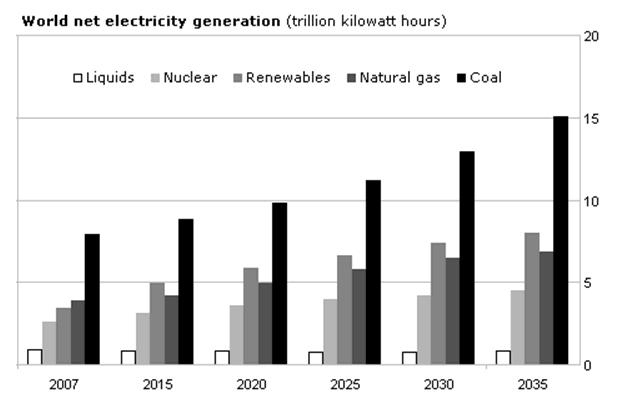If You Like the Big Trend in Gold, You Need to See the One in Coal
Commodities / Coal Jul 10, 2011 - 04:44 AM GMTBy: DailyWealth
 Matt Badiali writes: In yesterday's essay, Steve showed how profitable it is to own gold when the trend is up.
Matt Badiali writes: In yesterday's essay, Steve showed how profitable it is to own gold when the trend is up.
To most people, that sounds too simple to work... But as Steve highlighted, making money in the market often comes down just to sticking with the big trends.
That's why it's important to know about another big commodity uptrend...
It's the big uptrend in the price of coal.
As I'll show you today, despite all the bad press coal gets, it's in a major uptrend... and I expect it will be for at least the next decade...
Coal today is largely a story about electricity use... And the world consumes staggering amounts of power. Electricity is a fundamental fact of modern life. It powers virtually everything we do – from heating the stoves that cook our dinner and lighting up the TVs we watch, to powering the massive factories that build cars and refine natural resources.
And as countries like China and India (aka "Chindia") modernize their economies, the volume of electricity they devour is mind-boggling.
In the U.S. alone, we use almost 4 trillion kilowatt-hours of electricity every year, an amount the U.S. Energy Information Administration (EIA) says is growing about 1% a year.
Now, consider China. Power consumption there grew from 1.2 trillion kilowatt-hours in 2000 to about 4.5 trillion kilowatt-hours this year. That's a 275% increase in 11 years. India's consumption has grown from 375 billion kilowatt-hours in 2000 to more than 600 billion kilowatt-hours today. And 80% of that electricity is created by coal.
This table below, using numbers from the International Energy Agency, shows how "Chindia's" coal consumption is growing:
China |
India |
|
Total Coal Consumption 2009 (Tonnes) |
3.1 billion |
592 million |
Growth In Coal Consumption from 1973 to 2009 |
645% |
710% |
Growth in Coal Consumption from 2000 to 2009 |
154% |
74% |
Growth in Coal Consumption from 2008 to 2009 |
15% |
8% |
Environmentalists would like to change coal's vital role. Burning coal for power generation creates more pollutants than other fuels, like uranium and natural gas. But relatively poor economies like India and China are more concerned with the cheapest, most plentiful sources of power right now. They'll worry about cleanliness later. As long as coal is cheap and plentiful, it will serve as a cornerstone of the world's power industry.
This next charts shows the U.S. Energy Information Agency agrees with me. You'll note how coal is expected to play a huge role in power generation for decades:

In addition to Chindia's coal consumption, Japan's tsunami tragedy is a tailwind for prices. Japan and many other nations will be forced to burn coal if they want use less nuclear power (which is a big topic I'll cover another time).
But as I hinted at the beginning of this essay, the big thing to keep in mind here is the BIG TREND. Below is the trend in coal prices since 2002. When you slice out the crazy credit crisis action 2008, coal sports a solid uptrend that has lasted for years.

When I consider the bright economic future of massive countries like China and India (which collectively hold nearly 10 times the population of the U.S.), the world's recent aversion toward nuclear power, and the black stuff's big uptrend, I end up issuing my readers one piece of advice:
Get long coal, and stay that way for a long time.
Good investing,
Matt Badiali
The DailyWealth Investment Philosophy: In a nutshell, my investment philosophy is this: Buy things of extraordinary value at a time when nobody else wants them. Then sell when people are willing to pay any price. You see, at DailyWealth, we believe most investors take way too much risk. Our mission is to show you how to avoid risky investments, and how to avoid what the average investor is doing. I believe that you can make a lot of money – and do it safely – by simply doing the opposite of what is most popular.
Customer Service: 1-888-261-2693 – Copyright 2011 Stansberry & Associates Investment Research. All Rights Reserved. Protected by copyright laws of the United States and international treaties. This e-letter may only be used pursuant to the subscription agreement and any reproduction, copying, or redistribution (electronic or otherwise, including on the world wide web), in whole or in part, is strictly prohibited without the express written permission of Stansberry & Associates Investment Research, LLC. 1217 Saint Paul Street, Baltimore MD 21202
Disclaimer: The above is a matter of opinion provided for general information purposes only and is not intended as investment advice. Information and analysis above are derived from sources and utilising methods believed to be reliable, but we cannot accept responsibility for any losses you may incur as a result of this analysis. Individuals should consult with their personal financial advisors.
Daily Wealth Archive
|
© 2005-2022 http://www.MarketOracle.co.uk - The Market Oracle is a FREE Daily Financial Markets Analysis & Forecasting online publication.



